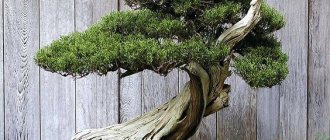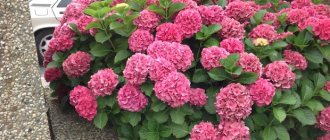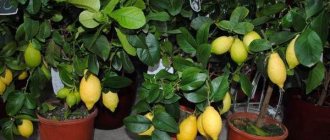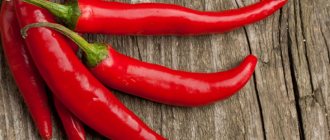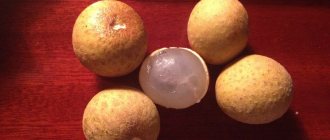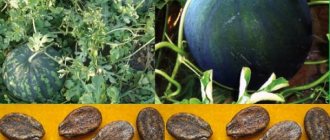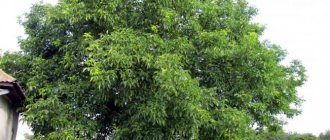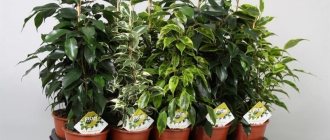Photo of Washingtonia in a pot Washingtonia (Washingtonia) is a genus of perennial woody plants from the Palm family (Arecaceae). The homeland of Washingtonia is the subtropics of the USA and Mexico.
In appearance, the plant is a fan palm. The leaves are split into numerous segments that radiate from the base of the blade.
Under natural conditions, the diameter of palm leaves reaches 1.5 m or more, the trunk length is up to 30 m. When kept in a container, Washingtonia grows up to 1.5-4 m. The growth rate is average. Life expectancy when grown indoors reaches 10 years or more.
At home, the plant rarely blooms, but in natural conditions it blooms at 10-15 years of age. Inflorescences are long panicles.
Be sure to check out similar plants:
| Hamerops - cultivation and care |
| Livistona - care |
| Washingtonia |
| Yucca home - planting and care |
| Average growth rate. |
| It blooms very rarely, in summer. |
| The plant is easy to grow. |
| Perennial plant, with good care about 15 years. |
Useful properties of Washingtonia
Thanks to the large leaf area, Washingtonia humidifies the air well. It is grown as an ornamental foliage plant. The fan palm is not so often seen in indoor culture due to its large size. Used for landscaping spacious rooms, offices, hallways of hospitals and hotels, etc. Helps create a calming, aesthetically pleasing environment.
Peculiarities
Washingtonia belongs to the arecaceae or palm family . Naturally distributed in Mexico and the southern United States.
In addition to its decorative value, the palm tree is famous for its resistance to cold. Therefore, they like to place it in cool foyers and halls, in winter gardens. In winter, Washingtonia can be kept in rooms with an air temperature of 5-10℃, since at this time it begins a dormant period.
Only young palm trees are kept indoors . She grows very quickly. After it reaches a large size, it is recommended to move it outside. This can be done in regions with mild climates. Washingtonia can withstand short-term frosts down to -5℃.
Under natural conditions, a palm tree can grow up to 30 meters, and the trunk diameter reaches 1 meter. The leaves of the plant are large, fan-like.
Features of care at home. Briefly
Let's briefly look at the basic requirements for growing Washingtonia at home:
| Temperature | Moderate: in winter not lower than 12 °C, in summer - up to 25 °C. |
| Air humidity | Increased. When kept in a heated room, spraying is necessary. |
| Lighting | Diffused light without direct sunlight. |
| Watering | In spring and summer - plentiful. In winter, keep the soil slightly moist. |
| Priming | Grows well in prepared palm soil. Drainage is required. |
| Feeding and fertilizer | During the growth period from spring to autumn, liquid complex fertilizers for palm trees are applied. |
| Transfer | This is done only in case of emergency, if the roots do not fit in the pot. Like all palms, Washingtonia does not like to be disturbed. |
| Reproduction | Seeds are germinated under film at a temperature not lower than 25°C. The time for the first leaf to appear is 2-3 months after sowing. |
| Features of cultivation | In summer you can take it out into the open air. Shade from direct sun. |
Flowering and dormant period of the plant
Indoor banana (banana palm) - home care
Washingtonia grown at home practically does not bloom. In nature, its flowers are quite spectacular, large, fragrant panicles. There is no clearly defined dormant period for this palm tree. But she is artificially immersed in this state for better growth and development. This occurs during the winter months when the room temperature drops.
Palm blossoms in nature are a stunning and unforgettable sight.
Caring for Washingtonia at home: detailed instructions
For cultivation to be successful, certain requirements must be met. Like other palm trees, Washingtonia at home needs cool wintering and moist air in summer.
Bloom
At home, even under good conditions, the Washingtonia palm blooms extremely rarely.
In nature, inflorescences are formed on the plant - long ears that emit a strong aroma. On the Black Sea coast, flowering occurs in June, fruit ripening in November.
Temperature
In winter and summer they maintain different temperatures. Optimal indicators: in summer 22-25 °C without overheating, in winter - not lower than 12 °C. In summer, the plant is taken out to an open balcony or garden. Household Washingtonia should be protected from frost and cold drafts.
Interesting! An adult plant growing outdoors can withstand temperatures down to -5-6 °C.
In the Russian climate, Washingtonia grows in open ground on the Black Sea coast (Sochi). But even there she needs shelter for the winter.
Spraying
Washingtonia requires moist air. Therefore, it needs to be regularly sprayed with warm water. It is better to do this in the morning so that all the droplets dry before the evening. Mature leaves are sometimes wiped with a damp sponge. In a heated room, the container with the plant is placed at a distance from the radiator.
Advice! You can increase the air humidity near the plant by placing a pot with a palm tree in a tray with wet expanded clay. Another option is to keep an open container of water near your Washingtonia.
Lighting
It is a mistake to consider Washingtonia a lover of the tropical sun. She needs bright, diffused light without direct sunlight. Partial shade is acceptable. To ensure such conditions, it is enough to keep the palm tree at a distance of 1.2-1.5 m from a sunny window or next to a western or eastern window.
Advice! If there is not enough natural sunlight in winter, you need to provide the plant with artificial lighting.
Watering
Washingtonia is watered moderately, but all year round.
In summer and spring it is quite abundant, keeping the soil slightly moist all the time. In winter, watering is reduced: after the top layer of soil has dried to a depth of 1 cm, wait another 1-2 days. During cold wintering, the watering regime is reduced to 1-3 times a month. The palm tree does not tolerate stagnation of water at the roots. Therefore, overwatering can lead to complete rotting of the root system and death of the plant. Excess moisture is especially dangerous in cold winter, when the absorption capacity of the roots decreases.
Pot for Washingtonia
Washingtonia does not have any special requirements for the pot. The selection options are standard. The size of the pot should correspond to the root system of the plant: when planting, 1.5-2 cm should remain between the earthen ball with roots and the walls of the pot. When growing a palm tree from seeds, take the first pot for a young sprout with a diameter of 6-9 cm, gradually increasing its size with each transplantation
The choice between a plastic and ceramic container is based on the personal preferences of the grower. The only requirement is that Washingtonia needs good drainage, so the pot must have a hole in the bottom to remove excess moisture.
Interesting! Plants in ceramic pots require more frequent watering than plants in plastic pots. When changing from a plastic pot to a pottery pot, care for Washingtonia at home must be adjusted.
Priming
The soil is selected so that it allows water and air to pass well to the roots. A special primer for palm trees from a trusted manufacturer is best. You can also make the soil yourself. To do this you will need turf, leaf and humus soil, sand in a ratio of 4:2:2:1. To loosen the soil, add perlite or vermiculite.
Feeding and fertilizer
For good growth of Washingtonia, regular fertilizing is required, since over time the nutrient content in the soil decreases. Fertilizers are applied from spring to autumn, that is, during the growth period. In winter they do not feed. Use complex mineral fertilizers for palm trees. If you don’t find these in the store, you can take a universal fertilizer for decorative deciduous plants.
The dose and frequency of application depends on the specific product and is indicated by the manufacturer on the fertilizer packaging. Usually it is enough to feed the palm tree every 10-14 days along with watering.
Important! Concentrated fertilization and fertilizing without watering can burn the roots and kill the plant.
Washingtonia transplant
Like all palm trees, Washingtonia is extremely sensitive to transplants, so they should only be done if absolutely necessary. During the first 5 years of life, the plant is transplanted every 1-2 years into a pot of larger diameter.
An adult plant needs to be replanted if the roots have reached the surface of the pot or grown through the drainage holes. After repotting, provide good care for your Washingtonia. In other cases, it is enough to change the top layer of soil annually.
Palm trees are replanted in the spring so that the roots have time to develop and adapt to the new pot before the onset of cold weather. Procedure:
- If the pot has been previously used, rinse it thoroughly. A new clay pot is soaked in water overnight.
- A layer of drainage up to ¼ of the pot must be poured onto the bottom of the container.
- The plant is watered and removed from the old container along with the earthen lump.
- Gently straighten the lower roots with your hands, if possible.
- Place the palm tree on a layer of new soil in a new container, gradually filling the gaps between the walls. The soil around the earthen ball is crushed.
- The plant is watered again and placed in the shade for a week to adapt. After this, they return to their usual place.
Trimming
As the palm tree grows, the lower leaves turn yellow and dry out. This is a natural process. Completely dried leaves are cut off.
Important! The only point of growth in palm trees is at the top of the stem. If the stem is cut, the plant will not produce side shoots and will die.
Rest period
The plant does not have a pronounced dormant period. A seasonal feature of maintenance is compliance with temperature and water conditions.
If on vacation
In winter, you can leave the palm tree unattended for 1-2 weeks. Before leaving, the plant is watered and placed in the center of the room away from bright light and heating devices. In summer, it is better not to leave a palm tree unattended for more than a week. If your vacation is longer, you can negotiate with friends or use automatic watering systems.
Growing conditions
Illumination
Many people mistakenly think that palm trees like to grow in direct sunlight, which harms the plant. Lighting is required to be bright, but diffused: place Washingtonia near an east- or west-facing window, the south window should be shaded with a tulle curtain.
Ideally, the duration of daylight hours should be 12-15 hours per day. In winter, it is necessary to use phytolamps or fluorescent lamps for illumination.
Air temperature and ventilation
For normal development, the palm tree needs access to fresh air. If possible, move to a balcony or garden for the summer season, but protection from direct sunlight is necessary. Ventilate the room regularly even in winter, but the plant should not be in a draft.
Keep the temperature moderately warm. When growing in a hall, winter garden or on a glazed balcony, protect from hypothermia. In spring and summer, the optimal temperature range is 22-25 °C, in winter – 10-12 °C, but not lower than 5 °C. Only an adult street palm tree can withstand frost down to -5 °C.
Growing Washingtonia from seeds
The plant is propagated only by seeds. They can be bought in specialized stores. Sowing is carried out in the spring and summer.
Procedure:
- To speed up seed germination, the thick shell is lightly filed with sandpaper or a nail file, not reaching the inside. Then the seeds are soaked in warm water for 2-7 days. The water is changed daily.
- The soaked seeds are sown in a loose substrate made from a mixture of soil, peat and sand to a depth of 1 cm.
- The top of the container is covered with film or glass.
- The seeds are removed to a warm place. For successful germination, a temperature of 25-30 °C is required.
- The glass or film is removed daily to ventilate the container. The substrate is kept moist by spraying the surface.
- The speed at which sprouts appear depends on the freshness of the seeds. The young ones sprout within 15-20 days. Old ones germinate in 2-3 months.
- After seed germination, the container is moved to a bright, warm place.
- Seedlings are planted in separate pots after the appearance of 2 true leaves.
Planting a Washingtonia palm
For mature plants, tall pots will be needed, but for young palm trees they are not necessary. Washingtonia has poorly developed fibrous roots, and the main root develops very long and makes several turns inside the pot. Its bulk is concentrated below, near the drainage layer. Over time, this root becomes lignified and, if the root system is handled carelessly during replanting, it easily breaks and dies.
Attention! Healthy roots of a Washingtonia palm tree, even if they are very long, cannot be cut off. During transplantation, they should be handled very carefully, because if the main root is damaged, the plant may die.
Like most domestic palm trees, representatives of this genus are sensitive to transplantation. Their owners try to resort to radical intervention in the root system only in very extreme cases - if there is a suspicion of disease or pest damage.
Young seedlings are replanted in the spring as they develop, middle-aged plants - once every 2-3 years. For large plants growing in tubs, only the top layer of the earthen clod, 5–10 cm thick, is changed. It is loosened carefully with a wooden stick so as not to touch the roots, removed with the palm of a rubber glove and a new substrate is poured.
Very often, the root system is exposed in the area of the root collar, which indicates that the pot for the palm tree has become cramped. However, there is no need to rush into transplantation work if the time is not right for it. It is enough to mulch the exposed roots with wet sphagnum, and then during watering, after the moss has dried, lift it, watering only the substrate between the roots, and leaving the sphagnum dry.
Flower growers who have bought Washingtonia in a flower shop often ask whether it is necessary to replant the plant immediately after purchase? It is desirable, since the pots with which the plant is sold contain a large proportion of peat, and the palm tree feels uncomfortable in it.
The soil mixture for growing Washingtonia is quite suitable, but the purchased one “For palm trees” is quite suitable, but it is absolutely possible to make it yourself. It is enough to take 2 parts of turf soil and 1 part each of humus, peat, leaf soil and sand. For very large specimens, the amount of turf component is doubled. A good drainage layer at the bottom, usually consisting of expanded clay with the addition of a small amount of pieces of birch charcoal, is important.
Diseases and pests
The main difficulties that gardeners face when growing palm trees mainly occur due to improper care:
- Washingtonia leaves turn yellow - insufficient watering or lack of nutrients. In summer, the roots of the palm tree should not dry out.
- Brown leaf tips indicate dry air. The plant needs to be sprayed more often. Dry ends can also be caused by lack of watering or cold air.
- Light dry spots on the leaves indicate excess light.
- The Washingtonia leaves wither and darken - the air temperature is too low.
- The apical bud rots - overwatering, too heavy, waterlogged soil.
- Rotting of the trunk - overflow, stagnation of water in the pot.
- The tips of the leaves dry out - dry air and insufficient watering.
- Dark spots have appeared on the leaves - spotting is often associated with overwatering or a sudden drop in temperature. If dark spots appear, you need to exclude pests (this could be spider mites).
Among the pests, palm trees are affected by spider mites, scale insects, and mealybugs.
Transfer
February or March is the best time to transplant. Plants up to 3 years old are replanted every year. Five-year-old plants should be replanted no more often than once every three or five years. Palm trees older than 10 years, as a rule, are not replanted. The top layer of soil in the tubs is removed, and the empty space is filled with fresh soil.
For replanting, you need to prepare soil consisting of the following components:
- turf substrate (2 parts);
- leaf substrate (2 parts);
- humus or peat (2 parts);
- sand (1 part).
For transplanting large mature palm trees, a similar composition is used, but twice as much turf soil is taken as other components. You can also add a little organic fertilizer to the soil for an adult palm tree during transplantation.
As the roots become exposed at the surface of the earth, you need to add fresh soil substrate to the pot.
Types of Washingtonia domestica with photos and names
Washingtonia filifera (Washingtonia filifera)
Palm tree up to 25 m high in natural conditions. When kept in a container, it grows up to 2-3 m. The leaves are fan-shaped, grayish-green. At the ends of the leaf segments there are thin white threads of fibers.
Washingtonia powerful or “in a baby skirt” (Washingtonia robusta)
The species is very close to W. filifera. The leaf petiole has spines along its entire length. The lifespan of each leaf is 3 years. The remains of dead leaves on the trunk form a sheath that looks like a skirt.
Why Washingtonia can be grown at home
Washingtonia is a tree that in its natural habitat grows up to 30 meters tall and has a trunk circumference of one meter. It is impossible to achieve such a plant size at home. It is almost as unrealistic to achieve its flowering when kept at home.
Washingtonia palm
This type of palm tree became a houseplant relatively recently. The following factors played a role here:
- Washingtonia is a rather unpretentious plant. It tolerates temperature changes calmly, requires watering, light and occasionally replanting.
Interesting. Planted outdoors, this tree can withstand frosts down to -5 degrees and even more.
- This palm tree looks very interesting. It has large spreading leaves divided into segments. They are very similar to fans.
- The variety cleans the air well, so it is recommended for polluted areas.
All this makes the Washingtonia palm an excellent option for indoor decoration.

